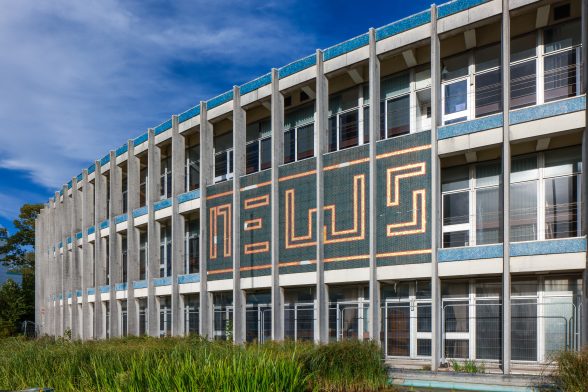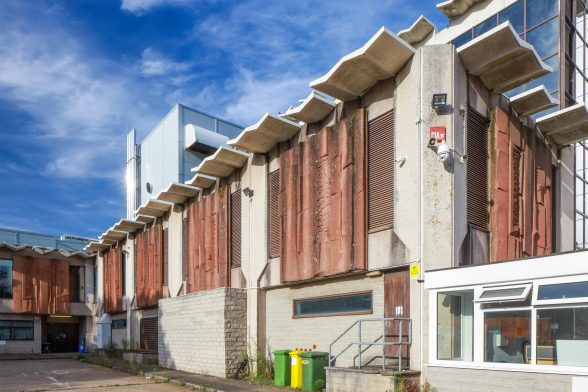This website uses cookies
This website uses cookies to enable it to function properly and to analyse how the website is used. Please click 'Close' to accept and continue using the website.



Image: John East
C20 has strongly objected to the proposed demolition of the News Centre in Hilsea- the former headquarters and printing hall of the Portsmouth Evening News – urging developers to retain the prominent curving office block and landscaping, and re-site the several William Mitchell sculptural reliefs as part of their plans.
Designed in 1966-67 by well-regarded local architects A. E. Cogswell & Sons, and featuring a set of sculptural relief panels by artist William Mitchell that run around the exterior of the printing hall, the facility was a purpose-built home for local and national journalism in the region for over 50 years. It closed in July 2022, following an acquisition by DMG Media (Daily Mail group) in October 2020. In March 2023 the site was sold transport operators First Group while in August, Portsmouth City Council gave permission to demolish the News Centre under permitted development rights. First Group intend to construct a new “super bus depot” capable of housing up to 90 electric vehicles.
C20 joined local opposition to the plans from the Portsmouth Society and requested the local authority issue an Article 4 Direction, to remove permitted development rights from the site. This would have required the applicant to apply for planning permission – a process which would allow for proper consideration of the site’s heritage significance in the decision-making process. Unfortunately the council snubbed this request and a separate listing application was also recently rejected by Historic England.

Image: John East
Innovative concrete
The News Centre featured in architectural publications Building (Nov 1966), Concrete (Mar 1967), Industrial Architecture (Mar 1967) and Interbuild (Mar 1967), which noted the building’s innovative use of concrete to create interesting architectural forms and achieve large (50-55ft wide) spans producing spacious and open interiors which could be easily adapted to allow for maximum flexibility.
Industrial Architecture (1967) reported that “Precast units from no less than six specialised concrete product manufacturers are being used to combine the speed and economy of industrialised building with freedom of layout and architectural treatment in the new […] Portsmouth Evening News” building. It was also innovative in its pre-stressing technique: British Ropes’s newly-developed ‘Dyform’ seven-wire strand was used “for what was thought to be the first time in this country” to give the concrete maximum strength (Building, 1966). Articles also noted the building’s high-quality external finishes, such as its exposed concrete surfaces which were treated with grinding to reveal the natural whiteness of the capstone aggregate and give “a marble-like finish”, and its areas glass mosaic.

Image: John East
William Mitchell artworks
Significantly, the exteriors were also fitted with abstract sculptural panels of sand-blasted concrete designed by the artist William Mitchell. Mitchell was a leading post-war British sculptor, represented by an impressive 16 artworks on the National Heritage List for England (NHLE).
Though the News Centre has suffered some alteration and loss of original fabric, its principal road-facing office exterior survives remarkably well, as do the original landscape features, including an ornamental pond, boundary railings and soft planting. While the print house has seen most adaptation over time, many of the Mitchell sculptural panels also remain in-situ. Such is the overall size of the site, retention and adaptation of the landmark office block and re-siting of the Mitchell artworks should be completely feasible, while allowing the proposals for an electric bus depot to proceed without resorting to complete demolition and loss of these heritage features.

Become a C20 member today and help save our modern design heritage.